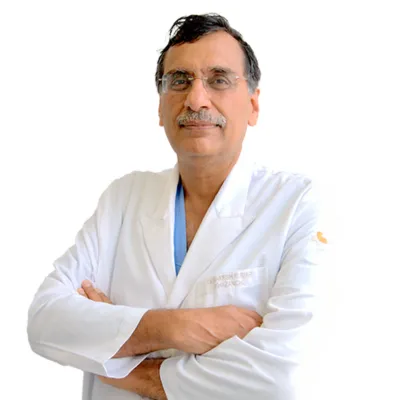Best Cardiologists in Artemis Hospital Gurgaon
 10 December,2025
Read More
10 December,2025
Read More
Starting From: USD 2400 - USD 3500
Hospitalization Days: 2 -3 Days
Procedure Duration: 4 Hrs - 6 Hrs
Body Lift Surgery is affordable in India. The cost of Body Lift Surgery in India lies between USD 2400 - USD 3500. The exact procedure price depends on multiple factors such as the surgeon's experience, type of hospital, severity of the condition, patient's general condition,�etc.
A body lift is a cosmetic surgery that helps people with excess skin or fat after significant weight loss. It tightens and firms skin around the abdomen, thighs, buttocks, and arms, creating a more contoured appearance. It's beneficial for those who have lost a lot of weight but have loose, sagging skin that diet and exercise alone can't fix. Body lifts improve body shape, restore confidence, and are often part of a transformative journey towards a healthier and more comfortable lifestyle.
Body lifts remove excess skin, improve body contours, boost self-confidence, alleviate physical discomfort, offer long-lasting results, provide a comprehensive solution for multiple areas, and empower personal transformation. They address concerns related to weight loss, pregnancy, ageing, and overall body shape, enhancing both appearance and well-being. Several reasons highlight the need for this procedure:
Body lifts encompass various procedures targeting specific areas for enhanced contouring. Examples include lower and upper body lifts, addressing the abdomen, hips, buttocks, chest, and back. Specialized lifts like arm and thigh lifts target specific regions, while full body and belt lipectomy offer comprehensive solutions. Non-surgical options provide alternatives for those seeking less invasive methods. Below are a few of its types:
The cost of a body lift is influenced by several factors, including the extent of surgery required, the surgeon's expertise, geographical location, facility fees, anesthesia costs, pre-operative tests, post-operative care, and any additional procedures combined. Individual patient factors such as medical history and desired outcomes also impact pricing. Let's explore some factors:
Patients are selected for body lift procedures based on medical evaluations, BMI, skin elasticity, extent of excess skin, overall health, realistic expectations, psychological readiness, and lifestyle factors. These considerations help determine candidacy and optimize outcomes for individuals seeking body contouring surgery. Here are some signs:
Before undergoing a body lift procedure, several diagnostic tests and evaluations are performed to ensure the patient's suitability and determine the need for surgery. These assessments help both the patient and the surgeon understand the current state of the body and what changes are desired:
By conducting these diagnostic tests and evaluations, surgeons can tailor the body lift procedure to each patient's unique needs, ensuring safe and effective outcomes.
Body lift procedures offer numerous benefits in terms of enhancing body contour, improving self-confidence, and addressing excess skin and fat. However, like any surgical procedure, they also come with inherent risks that patients should consider.
Recovery and rehabilitation after a deep body lift procedure are crucial aspects of the overall surgical process, ensuring optimal healing and long-term outcomes for patients.
In a body lift procedure, patients can expect a recovery process that involves various physical and emotional changes. Understanding what to expect post-surgery can help patients prepare for the journey ahead and optimize their recovery outcomes.
By understanding and preparing for the various stages of recovery after a body lift, patients can navigate the process more smoothly and achieve the best possible outcomes.
Body lift surgery is a comprehensive procedure designed to address excess skin and fat in multiple areas of the body, resulting in a more contoured and toned appearance. The surgery is typically performed under general anesthesia and involves several key steps:
Body lift surgery can effectively address excess skin and fat, resulting in a more sculpted and toned physique for patients seeking body contouring improvements.

Senior Consultant
Cosmetic Surgeon
Fortis Memorial Research Institute (FMRI), Gurgaon

Chairman
Cosmetic Surgeon
Medanta - The Medicity Hospital, Gurgaon
Doctor of Pharmacy
Dr. Deepanshu Siwach is a skilled clinical pharmacist with a Doctor of Pharmacy degree.?He has 4+?years of experience and has worked with thousands of patients. He has been associated with some of the top hospitals, such as Artemis Gurgaon.
Dr. Deepanshu Siwach is a skilled clinical pharmacist with a Doctor of Pharmacy degree.?He has 4+?years of experience and has worked with thousands of patients. He has been associated with some of the top hospitals, such as Artemis Gurgaon....
With over 23 years of experience, Dr. Vipul Nanda, an eminent Plastic and Cosmetic Surgeon, excels in surgical and non-surgical procedures, including filler, mesotherapy, laser, and dermatology....
Body lift surgery duration varies depending on the extent of correction needed and the specific areas targeted. On average, it typically takes between four to eight hours to complete. However, more complex cases may require longer surgical times. Your surgeon will provide a more accurate estimate based on your individual needs during the consultation.
The success rate of body lift surgery is generally high, with many patients achieving their desired outcomes. Success depends on factors like patient health, surgeon skill, and adherence to post-operative care. Complications are possible but rare when the procedure is performed by a qualified plastic surgeon in suitable candidates.
The recovery process after a body lift involves rest, wound care, and a gradual return to normal activities. Patients may experience swelling, bruising, and discomfort, which can be managed with pain medication and compression garments. It's essential to follow your surgeon's instructions for optimal healing and to avoid strenuous activities until cleared by your doctor.
After body lift surgery, pain management typically includes prescription pain medications to alleviate discomfort. These may be taken orally or administered through an intravenous line during the initial recovery period. Your surgeon will provide specific instructions on how to take your medications and manage pain effectively during the healing process.
Returning to normal activities after a body lift varies for each individual. Generally, patients can expect to resume light activities within a few weeks but should avoid strenuous exercise and heavy lifting for several weeks to months. It's essential to follow your surgeon's guidance and gradually increase activity levels to ensure a safe and successful recovery.
Physical therapy is not typically required after body lift surgery. However, patients may benefit from gentle stretching exercises and gradually increasing physical activity to aid in recovery and improve mobility. Your surgeon may provide specific post-operative instructions to promote healing and optimize long-term results, but formal physical therapy is not usually necessary for most patients.
The longevity of a body lift varies depending on individual factors such as age, lifestyle, and skin elasticity. Generally, results are long-lasting, but natural ageing and lifestyle changes may affect outcomes over time. Maintaining a healthy lifestyle and weight can help prolong the effects of the procedure, ensuring continued satisfaction with the results.
Insurance typically does not cover body lift surgery as it's considered a cosmetic procedure. However, in some cases, insurance may provide coverage if the surgery is deemed medically necessary, such as after significant weight loss causes health issues. Patients should consult with their insurance provider and surgeon to determine coverage options and potential out-of-pocket expenses.
After a body lift, adopting a healthy lifestyle is crucial for maintaining results. Patients may need to incorporate regular exercise, a balanced diet, and hydration into their routine to support overall health and prevent weight gain. Avoiding smoking and excessive alcohol consumption can also promote optimal healing and long-term outcomes.
Alternative treatments to body lift surgery include non-invasive procedures like laser therapy, radiofrequency treatments, or injectable fillers, which can address specific concerns with less downtime. However, these options may offer less dramatic results compared to surgery and may not be suitable for everyone. Consulting with a qualified plastic surgeon can help determine the best approach for individual needs.
The primary difference between traditional and robotic-assisted body lift lies in the surgical approach. Traditional methods involve manual techniques, while robotic-assisted procedures incorporate robotic technology for enhanced precision. The choice depends on the surgeon's expertise and the patient's specific needs. Both approaches aim to achieve similar outcomes, providing contouring and toning benefits.
Post-surgery, gentle stretching exercises and low-impact activities like walking are recommended to aid in recovery and promote circulation. Patients should avoid strenuous exercises or heavy lifting until cleared by their surgeon. Gradually increasing activity levels as tolerated can help rebuild strength and flexibility while minimizing the risk of complications.
The Art of Effective Communication
 10 December,2025
Read More
10 December,2025
Read More
 09 December,2025
Read More
09 December,2025
Read More
 05 December,2025
Read More
05 December,2025
Read More
 04 December,2025
Read More
04 December,2025
Read More
 27 November,2025
Read More
27 November,2025
Read More
 25 November,2025
Read More
25 November,2025
Read More